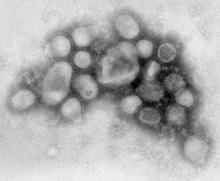African Americans, Hispanics, American Indians, and Alaska Natives were hospitalized for the H1N1 flu at rates that were nearly twice those of whites, according to a report from the Trust for America’s Health.
The report, Fighting Flu Fatigue, also found that both H1N1 and seasonal flu vaccination rates were lower for African Americans and Hispanics than they were for whites.
The lower rates for immunizations and higher hospitalization rates among minority populations could reflect lower rates of health care coverage among those groups, Litjen Tan, Ph.D., director of medicine and public health for the American Medical Association, said in a conference call discussing the findings.
"If you have coverage, if you have insurance, you’re more likely to access care [more quickly] than if you don’t," Dr. Tan said. "If you’re insured, you’re going to go in faster," for care before hospitalization becomes necessary.
The report found that African American hospitalization rates from the H1N1 flu were 29.7/100,000 people, compared with white hospitalization rates of 16.3/100,000 people. Hispanic hospitalization rates were 30.7 /100,000 people, and American Indians/Alaska Natives had a hospitalization rate of 32.7/100,000 people.
Some specific states and cities studied also found that mortality rates from H1N1 were much higher in minorities than in whites, the report said. For example, in Illinois, the mortality rate for Latinos was 6/100,000 and the mortality rate for African Americans was 7 /100,000, compared with 3/100,000 for whites.
Meanwhile, H1N1 vaccination rates were generally lower for minorities than for whites, although there were some variations.
In African Americans, vaccination rates were 9.8% lower for adults and 4.2% lower for children, compared with the rates for whites.
In Hispanics, vaccination rates were 11.5% lower for adults than for whites, but rates for Hispanic children were 5.5% higher than for whites. Seasonal flu vaccination rates were 21.7% lower for Hispanic adults and 2.6% lower for Hispanic children than for whites, the report found.
By the end of June 2010, about 27% of all Americans had been vaccinated against H1N1, the report said. About 70% of seniors and 24% of adults under age 50 get a seasonal flu vaccine each year, according to Dr. Tan.
The Trust for America’s Health report urged new measures to build on the success of the efforts to prevent the H1N1 flu and improve overall vaccination rates. The United States risks going back to a "national complacency" surrounding the flu, rather than building on last year’s efforts, Jeffrey Levi, Ph.D., the group’s executive director, said during the briefing on the report.
"We’re at a crossroads," he said. "The flu is often seen as nothing more than a simple nuisance," but it causes significant morbidity and mortality that’s "largely preventable with vaccine."
To improve vaccination rates, physicians and public health officials should strive to make getting a flu vaccine as easy and as routine as possible, Dr. Tan said. "Getting a flu vaccine every year should be a routine part of your fall activities," he said. "When you get a turkey for Thanksgiving or presents for Christmas, you should think of getting a flu vaccine."
In addition, physicians and public health officials need to continue encouraging health care workers to get flu vaccines and to that ensure pharmaceuticals and medical equipment are up to date in case of an outbreak, the report said.
The Trust for America’s Health study was supported by a grant from the Robert Wood Johnson Foundation.

